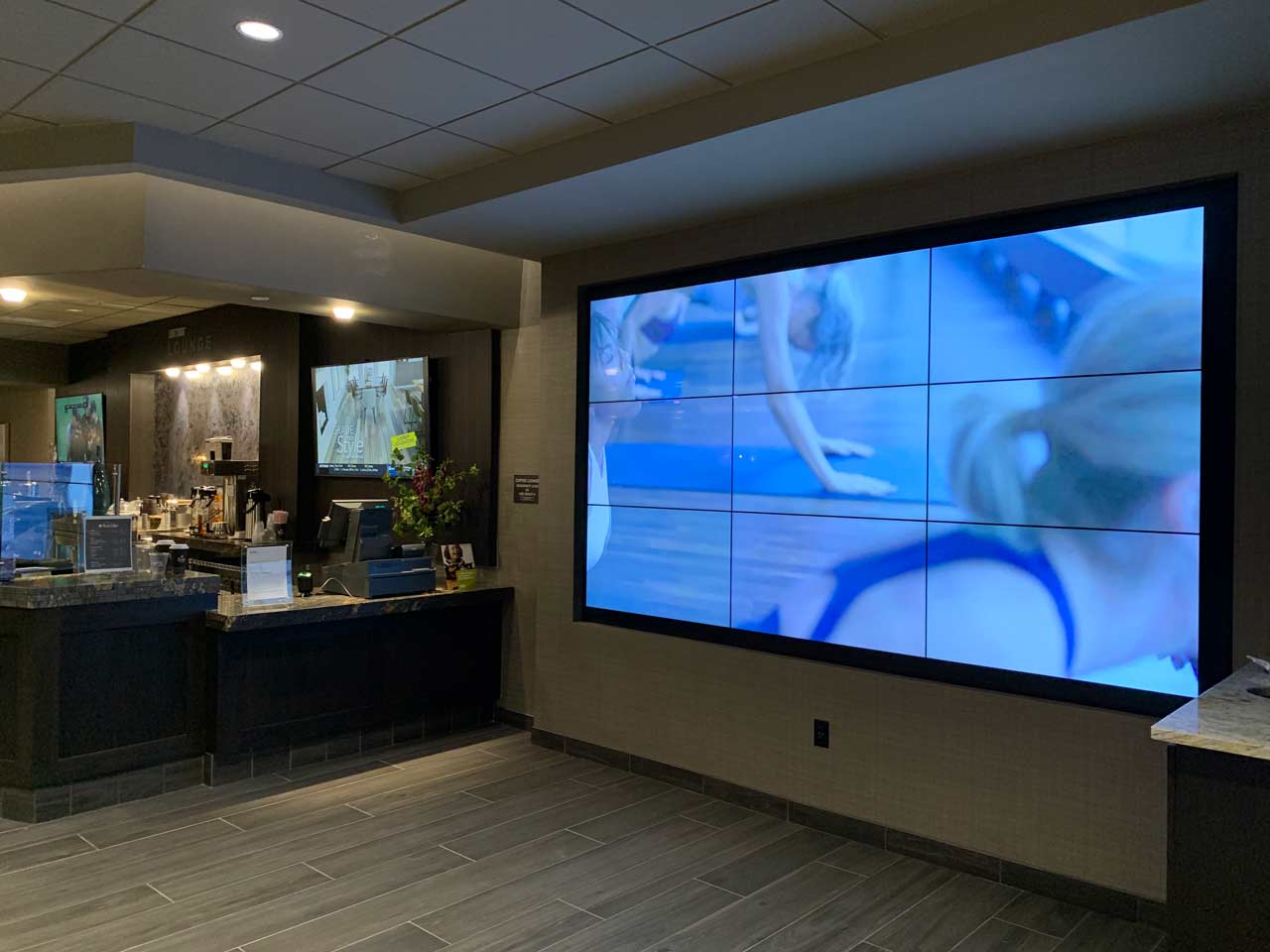What is a Video Wall TV?
What is Video Wall?
Digital Video walls are multi-screen setups comprised of multiple monitors, TVs or displays that are tiled together to create one large display. The number of displays used in a video wall can vary depending on the size of the wall and the resolution desired, but the most common configurations are 2×2, 3×3, and 4×4. The displays can be any type of display, including LCD, LED, and plasma.
Video walls are often used in public places such as airports, convention centers, and stadiums to screen information or advertisements. Many businesses also use video wall TVs to showcase products or services, or to screen company information such as news updates or financial data. Quick-service restaurants also use video walls for their in-restaurant and drive-thru digital menu boards.
What are the benefits of using a video wall?
There are many benefits to using a video wall, such as the ability to screen multiple images at once, the increased visibility of the content, and the ability to create a custom screen that fits the specific needs of your business. Video walls are also a great way to engage customers and provide them with an immersive experience.
What type of businesses can benefit from using a video wall?
Any business that wants to screen multiple images, or that wants to create a custom display, can benefit from using a video wall. Businesses that want to engage customers and provide them with an immersive experience will also find them to be beneficial. If you are looking for a way to improve the way your business communicates with customers, or if you want to create a custom display, a video wall may be the perfect solution.
If you are considering using a video wall for your business, LEDs are a great option as they can be customized to fit the specific needs of your business. LED digital video walls offer many benefits over other types of displays, such as a higher contrast ratio, better color reproduction, and a wider viewing angle. LED walls are also more energy efficient than other types of displays, which can help to reduce operating costs.

Benefits of using a video wall vs a large format display
There are many benefits of using a video wall over a large format display, such as the ability to screen multiple images at once, the increased visibility of the content, and the ability to create a custom screen that fits the specific needs of your business. Digital Video walls are also a great way to engage customers and provide them with an immersive experience. Large format displays are typically only able to screen a single image, which can make them less effective for businesses that want to showcase multiple products or services.
What type of businesses can benefit from using video wall TVs?
The type of business that should use a video wall depends on the specific needs of the business. However, video walls can be a great addition to any business that wants to grab the attention of its audience and deliver important information in a clear and concise manner.
Video walls are commonly used by a variety of businesses, including airports, convention centres, stadiums and retailers. They are often used to screen information or advertisements. Many businesses also use video walls to showcase products or services, or to screen company information such as news updates or financial data.
What is a video wall processor, and do I need one?
A video wall processor is a device that connects different video sources to one or more screens. You can use it to set up unique displays or to link several screens to make a video wall. These processors have various input and output ports, so they work with many kinds of devices. Usually, you don’t need a video wall processor to make a video wall.
But, if you want a special display or need to link several screens, you might need a processor. When choosing one, think about what your business needs and where you’ll install it. With the right planning, a video wall processor can be a valuable asset for your business.
Video walls are getting more popular in places like businesses, convention centres, and stadiums. They have advantages over standard displays, like showing multiple images at once, creating unique displays, or giving customers an immersive experience.
LED vs LCD Video Wall TVs
When choosing a video wall system, it’s important to pick one that fits your business’s needs. There are many types available, so finding the right one is key. The first big decision is whether to use LCD or LED displays, as each has its own pros and cons.
LCD video wall tvs are often chosen by businesses for their high-quality images at a lower cost. They have a wide viewing angle and deliver bright, clear images. However, LCDs aren’t as long-lasting as LEDs and can have issues like image retention or ghosting after long use.
LED video wall tvs, while more costly than LCDs, have several benefits. They provide sharper images due to a higher contrast ratio. LEDs don’t have problems with image retention or ghosting and are more durable. But they do use more power and might generate more heat compared to LCD digital video walls.
Do I need a special system to manage my videowall?
No, you don’t need a special system to manage your digital video wall content. You can use any type of computer with multiple monitors or a dedicated video wall controller. However, if you want to create custom displays or use real-time video sources, you may need specialized video wall software or hardware. Video wall controllers are available from a variety of manufacturers, and many offer software that can be used to create custom displays or control video wall content.

Content strategies for video wall content
There are a number of content strategies that can be used for video wall content. The most important thing is to ensure that the content is relevant to your audience and that it is updated on a regular basis. You should also consider using a mix of static and dynamic content to keep your audience engaged. Static content, such as images or text, can be used to convey important information, while dynamic content, such as video or animation, can be used to capture your audience’s attention.
When planning your content, it is important to consider the overall goals of your display. Are you trying to inform your audience? Entertain them? Or both? Once you know what you want to achieve with your videowall, you can start planning the content that will help you reach your goals.
Can I screen different types of content?
Yes, you can screen different types of content on your video wall. The most common types of content are images, videos, and text. However, you can also use animation, audio, and even interactive content on your video wall. The type of content you use will depend on the overall goals of your display. If you want to inform your audience, you’ll likely use mostly static content, such as images and text. If you want to entertain your audience, you’ll likely use mostly dynamic content, such as video and animation.
Should I use one or multiple players to drive your video wall content?
The number of displays used in a digital video wall content will depend on the type of content you want to display. If you are only displaying static content, such as images or text, you can likely get by with a single player. However, if you want to screen dynamic content, such as video or animation, you will likely need multiple players. The number of players you need will also depend on the resolution of your video wall. If you have a high-resolution wall, you may need more players to avoid image quality issues.
Difference between a video wall and a projector
There are a few key differences between video walls and projectors. They are typically made up of multiple displays that are placed side-by-side to create one large display. Projectors, on the other hand, use a single screen to project an image onto a surface, such as a wall or a screen. Projectors are more commonly used in business settings, such as boardrooms and classrooms, to give presentations or show video content.
Another key difference between video walls and projectors is that videowalls can be made up of any type of display, including LCD, LED displays, and plasma displays. Projectors are typically limited to using LCD or DLP displays.
Can I create a video wall made up of SoC displays?
A video wall can be made up of SoC displays. SoC displays are a type of screen that has all the necessary components to screen video wall content built into the screen itself. This means that you do not need any additional equipment to connect the screen to a video source. SoC displays are a great option for video walls because they are easy to set up and do not require any additional equipment. However, they are typically more expensive than other types of displays.
How to design in a non-standard resolution
If you want to create a video wall in a non-standard resolution, you will need to use multiple displays. The number of displays you will need will depend on the resolution you want to achieve. For example, if you want to create a 4K video wall, you will need four 1080p displays. You can then arrange the displays in any configuration you like to achieve the desired resolution.
Keep in mind that you may need more than four displays if you want to achieve a higher resolution. You will also need to make sure that the video content you are displaying is formatted to fit the new resolution. Otherwise, you may see black bars on the sides of the video, or the video may appear stretched.
Conclusions
So what is video wall, Video walls are a great way to grab the attention of your audience and deliver important information in a clear and concise manner. When selecting a system, it is important to consider the specific needs of your business. There are many different types of video wall systems available on the market, so it is important to find one that meets the specific requirements of your business.
Video walls can be an effective way to showcase products or services, screen company information, or simply entertain your audience. When used correctly, they can be a powerful marketing tool.
About Navori Labs
Navori Labs, a Swiss software innovator, delivers premium digital signage software and AI-driven marketing analytics solutions to businesses and organizations worldwide.
What differentiates our software is the fact it’s developed by our own team of engineers. For the last 20 years, Navori Labs has steadily invested in research and development. This lets us bring to market unique products that outperform other software solutions. It’s also why we back our products with professional maintenance contracts and support services.
We pay a lot of attention to our software’s simplicity, user-friendliness, and ease of use. Our digital signage software is designed for non-technical users, under the expert guidance of our in-house artistic director.
